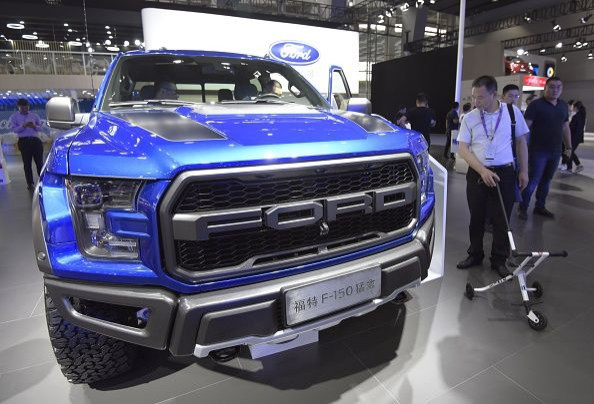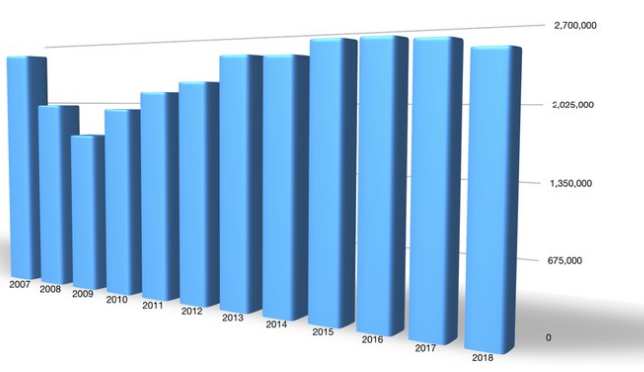Why Ford's US Sales Fell In 2018 -- They Might Rise In 2019

Ford Motor Company (NYSE:F) said that its U.S. sales dropped 8.8% in December, adding to concerns that the U.S. new-vehicle market may be slowing after years of robust sales. For the full year, Ford's U.S. sales were down 3.5%.
This article originally appeared in The Motley Fool.
Here's a look at what was working for Ford as 2018 drew to a close, what wasn't, and how things might shape up for the Blue Oval in its home market in 2019.
What worked for Ford in 2018 -- and what didn't
While overall sales were down, Ford still had quite a few things to brag about in its year-end sales presentation.
- U.S. sales of Ford's F-Series pickups, its most important driver of profits, were up 1.4% in 2018 to 909,330 trucks sold. Better yet, F-Series transaction prices hit an all-time high as buyers continued to choose well-optioned models. And yes, the F-Series continued its streak as America's best-selling trucks, something that has been true for the last 42 years.
- Ford's biggest SUVs had a great year, following the introduction of all-new (and much-improved) versions late in 2017. Sales of the Lincoln Navigator rose 69.5% to 17,839 sold, with average transaction prices far higher than the model it replaced. Sales of its sibling, the Ford Expedition, rose 5.4% to 54,661. But that doesn't capture the full story: Fleet sales of the Expedition were down, while (higher-profit) retail sales rose 35.4% from the year prior.
- The most recent addition to Ford's U.S. lineup, the small EcoSport SUV, sold 54,348 units in its first year -- enough to push Ford's total U.S. SUV sales to an all-time record.
- Because trucks and SUVs tend to sell at higher prices (with better margins) than sedans, the strong results for Ford's truck models helped push Ford's overall average transaction price to $38,400 in December, up $1,600 from a year ago and about $4,400 above the industry average.
But there were signs of trouble as well
- Ford's sedan sales were hit very hard in 2018. Sales of Ford's cars as a group were down 17.7% in 2018, with all models down year over year except the ultra-expensive GT sports car (126 sold in 2018, versus 89 in 2017) and the now-discontinued (and heavily discounted) subcompact Fiesta.
- Ford's product-overhaul strategy includes a renewed emphasis on performance vehicles, which the company has identified as a strength. But sales of its high-performance mainstay, the iconic Ford Mustang, fell 7.4% in 2018. (Meanwhile, sales of a key Mustang rival, Fiat Chrysler Automobiles' Dodge Challenger, rose 3% to an all-time high last year.)
- As part of an ongoing effort to boost profit margins, Ford has been working to revamp the Lincoln luxury brand for several years now. Results in China have been pretty good, but the U.S. market was less receptive in 2018. Lincoln's U.S. sales fell 6.8% last year, with sales of all models except the Navigator down versus 2017.
Can Ford turn things around in 2019?
To a large extent, Ford is at the mercy of the overall U.S. market: If consumer confidence drops, sales of new vehicles will fall. Sooner or later, that will happen, and it's likely that we're much closer to the end of the current economic expansion than we are to the beginning.

But looking beyond the economy, at least some of Ford's so-so 2018 U.S. sales result can be attributed to the timing of its product-replacement cycle. Remember that new vehicles are planned three to four years in advance: four years ago, all-new versions of the Focus and Fiesta for 2018 looked like pretty good bets. Those new models are in fact doing quite well in Europe, but Ford decided not to offer them in the U.S. -- leaving its U.S. showrooms with little in the way of new products in 2018.
That will change over the next couple of years. The new midsize Ranger pickup will begin arriving at dealerships shortly, followed by all-new versions of the big-selling Explorer and Escape SUVs later this year. Two all-new off-road SUVs will arrive in 2020, along with a revamped version of the all-important F-150 pickup -- and more.
How will all that play out? It's hard to know given the economic variables, but we can say this: New products almost always sell in higher numbers and at considerably better prices than products that are near the ends of their production runs.
No matter what the economy does, Ford's sales (and margins) will almost certainly be better with more new products in its U.S. showrooms than they would have been without. For investors eyeing Ford's fat dividend but concerned about slumping sales and profits, that's unambiguous good news.
John Rosevear is the senior auto specialist for Fool.com. The Motley Fool has a disclosure policy.




















